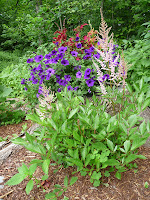Today's discussion addresses the latter issue, pests.
While we're certainly not void of a long list of critter and insect pests; my biggest challenge in recent years past has been with my lovely friends, the white tailed deer, who can wipe out weeks of your hard labor in a single feeding.
Perhaps the local deer herd has increased due to milder winters or perhaps they simply know that my entire yard is a veritable salad bowl or perhaps it's because they know I don't eat them. Whatever the reason, the amount of damage has increased substantially over time.
About 15 years ago I installed a funky, rough cut picket style fence surrounding the veggie garden creating a separation from the veg and perennial beds.
I installed the 36" high wooden fence strictly for esthetics with full knowledge that it wasn't adequate for keeping any critter out including my standard dachshund who could easily scooch underneath.
When a large poplar tree fell over winter taking out several sections of fence I realized my opportunity to try and address the deer issue once and for all and came up with a plan.
I decided to replace every corner post as well as the gate posts with 10' 4x4 hemlock posts sunk 4' down. This left a very stable 6' above ground creating the anchor by which to attach the deer fencing.
Deer fencing is a mesh like, high strength and lightweight material made of UV stable black polypropylene plastic.
It's affordable, easy to install and comes in rolls of various sizes and tensil strength.
A quick search online will bring you to plenty of sites but Deer Busters is an excellent site that provides a broad range of products and options.
Since I only needed to cover the area above my already existing 3' fence; I simply cut the mesh fencing (cuts easily with a scissor) in half lengthwise (in this case into 40" widths) to cover the open area and reach the max height of 6'.
The method I used to install the deer 'mesh' was to first attach eye screws (see inset photo) to the posts several inches below the tops of the posts.
I then tied an orange coated wire which I had leftover from another project to one eye screw and cut to a lenth 12" longer than the opposite post. Any wire strong enough to be pulled tight would do but I already had this wire for one thing and I also felt the colored wire would act as a visual alert for any deer approaching the garden since the 'mesh' has a tendency to blend into the landscape; a feature I particularly find appealing.
Then I simply wove the wire through the top of the mesh fencing, thread the other end of the wire through the opposite eye screw and pulled the wire as tight as I could and tied it off.
Simple tacking to the fence and posts and that was that.
I then added a few architectural features by creating an arbor like header above both front and rear gates and made bird houses that I mounted on the tops of each corner post.
House wrens moved into the 2 front corner houses less than 24 hours after I mounted them ( I love their chattering) creating the final interest to a full garden pallette.
I'm really pleased with the end result although I realize that I could be speaking too soon since I won't know that my efforts have proven success until I know that no deer has entered the garden.... but I'd like to remain optimistic and will add my findings as an update to this post at the end of the season.
Deer or no deer... only time will tell.



















